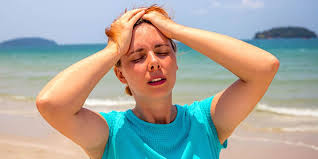While summer often brings relaxation, vacations, and outdoor fun, it also presents unique health risks—particularly for stroke. According to Bayhealth Nurse Practitioner Brandy Magee, MSN, APRN, FNP-C, many summertime behaviors can unknowingly increase stroke risk and even mask the early warning signs. In a season filled with heat, hydration challenges, and dietary indulgences, recognizing and responding to stroke symptoms becomes more critical than ever.
This guide explains how to recognize stroke symptoms, reduce your risk during the summer, and take proactive steps to protect your health year-round.

What Is a Stroke and Why Time Matters
A stroke occurs when blood flow to a part of the brain is either blocked (ischemic stroke) or when a blood vessel bursts (hemorrhagic stroke). Without oxygen, brain cells begin to die rapidly—leading to long-term damage or death.
Every second of delay during a stroke emergency results in the destruction of one billion brain cells. That’s why knowing the symptoms and acting quickly can save lives and reduce disability.
The FAST Way to Recognize Stroke Symptoms
The most effective way to detect a stroke early is by remembering the F.A.S.T. acronym:
-
Face: One side of the face drooping or feeling numb
-
Arms: Inability to raise both arms evenly
-
Speech: Slurred or incoherent speech
-
Time: Time to call 911 immediately
Additional Stroke Symptoms to Watch For:
-
Sudden numbness or weakness in the face, arm, or leg (especially on one side)
-
Sudden vision issues in one or both eyes
-
Trouble walking, dizziness, or loss of balance
-
A severe headache with no known cause
-
Sudden confusion or trouble understanding speech
Nurse Practitioner Magee warns, “People often ignore these signs, mistaking them for minor issues like dehydration or exhaustion. This delay can lead to devastating consequences.”
Summer Habits That Can Disguise Stroke Symptoms
Warm-weather activities and rituals can sometimes blur the lines between a good time and a medical emergency.
Alcohol Consumption and Stroke Symptoms
Many symptoms of a stroke—like slurred speech or confusion—are also associated with alcohol intoxication. This similarity often causes stroke symptoms to go unnoticed during summer parties and barbecues.
Sodium and Dehydration: A Risky Combination
Summer foods like chips, hot dogs, and processed meats are high in sodium, which can spike blood pressure. Combined with summer heat, these salty snacks contribute to dehydration—a dangerous stroke risk factor.
Heat and Outdoor Activity
Excessive sweating and exposure to high temperatures can lead to fluid loss, thickening your blood and increasing clot risk. Staying hydrated is essential, especially if you’re spending time outdoors.
Diabetics Must Be Extra Cautious
Those living with diabetes are twice as likely to experience a stroke. Magee emphasizes the importance of monitoring carbohydrate intake, especially at social events where sugary drinks and refined carbs are common.
High blood sugar levels can damage blood vessels over time, making diabetics more susceptible to stroke and other cardiovascular events.
Medication Adherence: Your Lifesaving Routine
Summer travel and disrupted routines can cause people to skip or forget medications, increasing their vulnerability to stroke.
Must-Do Tips:
-
Refill prescriptions before leaving for vacation
-
Pack enough doses for the entire trip, plus extras
-
Stick to your schedule, even during holidays or outings
“Missing just one dose of blood thinners like Coumadin can drastically increase stroke risk,” says Magee. This applies to blood pressure medications, cholesterol-lowering drugs, and antiplatelet agents as well.
The Power of Follow-Up Care
Surviving a stroke is only the beginning. Follow-up care with your primary care provider, cardiologist, and neurologist is crucial in preventing a second stroke, which is often more dangerous.
Regular checkups help:
-
Monitor blood pressure and cholesterol
-
Manage medication side effects
-
Adjust treatment plans for better results
Skipping appointments post-stroke can lead to recurring incidents that may have been prevented with timely intervention.
How to Reduce Your Stroke Risk This Summer and Beyond
Smart Summer Stroke Prevention Checklist
1. Moderate Alcohol and Salty Foods
-
Drink alcohol in moderation and avoid binge drinking
-
Choose fresh, whole foods over processed, salty snacks
2. Stay Hydrated
-
Aim for at least 8–10 cups of water daily
-
Increase fluid intake if you’re sweating or spending time in the sun
3. Manage Diabetes and Carbohydrate Intake
-
Avoid sugary beverages and refined carbs
-
Stick to a diabetic-friendly diet to stabilize blood sugar
4. Stick to Your Medication Plan
-
Use reminders or alarms to stay on schedule
-
Carry a small pill organizer if traveling or out all day
5. Act Immediately at the First Sign of a Stroke
-
Don’t second-guess symptoms
-
Always call 911 rather than driving to the ER
Frequently Asked Questions:
Q1. Why is stroke risk higher in the summer?
High temperatures, dehydration, and dietary changes (more salt, alcohol) contribute to higher stroke risk in the summer months.
Q2. Can alcohol consumption disguise a stroke?
Yes. Stroke symptoms such as slurred speech or unsteady walking may be mistaken for intoxication, delaying critical treatment.
Q3. How much water should I drink to prevent dehydration-related stroke?
Most adults should drink 8–10 cups daily, with increased intake during outdoor activity or extreme heat.
Q4. What happens if I miss a dose of my stroke medication?
Missing doses—especially blood thinners or blood pressure meds—can increase your risk of clot formation and stroke recurrence.
Q5. Can young people have strokes in the summer?
Yes. Stroke doesn’t discriminate by age. High temperatures, partying, and underlying conditions can affect younger individuals as well.




